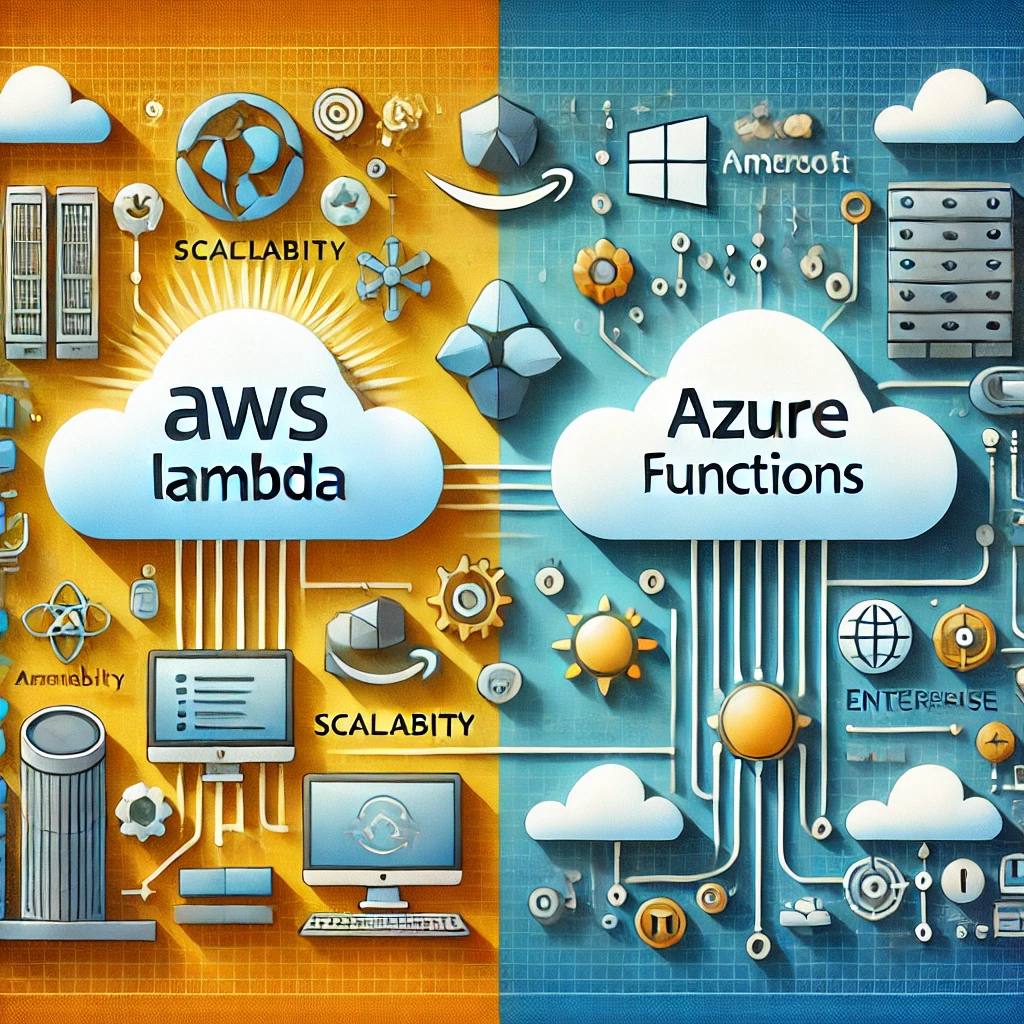Serverless computing has revolutionized how developers approach application development, enabling rapid scaling, cost-efficiency, and simplified infrastructure management. Two of the leading platforms in this space are AWS Lambda and Azure Functions. As we approach 2025, it’s crucial to understand the key features, benefits, and latest updates of these platforms to make informed decisions.
Overview of AWS Lambda
AWS Lambda is Amazon’s serverless computing platform, enabling developers to run code without provisioning or managing servers. It automatically scales based on demand, allowing you to execute code in response to events from other AWS services or HTTP requests.
Key Features (2025):
- Graviton2/3 Processor Support: Enhanced performance and cost efficiency with ARM-based processors.
- Function URLs: Simplified creation of HTTPS endpoints for Lambda functions.
- Lambda SnapStart: Reduced cold start latency for Java functions by pre-initializing execution environments.
- Streaming Payloads: Efficient processing of large event payloads for data-intensive applications.
- Expanded Runtime Support: Latest versions of Python, Node.js, and .NET are supported.
- Enhanced Observability: Built-in integration with Amazon CloudWatch and AWS X-Ray for detailed monitoring and tracing.
Pricing Model:
- Pay-per-use based on the number of requests and execution time.
- Free tier includes 1 million requests and 400,000 GB-seconds per month.
Overview of Azure Functions
Azure Functions, Microsoft’s serverless platform, provides event-driven, scalable computing capabilities. It integrates seamlessly with the Azure ecosystem, offering extensive functionality for enterprises heavily invested in Microsoft technologies.
Key Features (2025):
- Premium Plan Enhancements: Consistent performance with reserved instances and VNet connectivity.
- Durable Functions Updates: Improved orchestration for complex workflows.
- Event Grid Integration: Streamlined event handling with support for new event types.
- Containerized Deployments: Kubernetes-native Azure Functions with Azure Arc.
- Built-in CI/CD Pipelines: Enhanced deployment efficiency through Azure DevOps and GitHub Actions integration.
- Advanced Monitoring: Detailed insights via Azure Monitor and Application Insights.
Pricing Model:
- Consumption-based pricing or fixed-cost premium plans.
- Free tier includes 1 million requests per month and 400,000 GB-seconds of execution time.
Head-to-Head Comparison between AWS Lambda and Azure Functions:
| Feature/Aspect | AWS Lambda | Azure Functions |
|---|---|---|
| Ease of Use | Simple setup with AWS Management Console | Seamless integration with Visual Studio |
| Cold Start Performance | Improved with Lambda SnapStart | Enhanced with Premium Plans |
| Runtime Support | Wide range including Go, Rust, Java | Extensive, with .NET Core and JavaScript |
| Integration Ecosystem | Native AWS services (S3, DynamoDB, etc.) | Native Azure services (Blob Storage, Event Hub) |
| Scaling | Fully automatic scaling | Event-driven scaling with manual control options |
| Monitoring and Debugging | CloudWatch and X-Ray | Azure Monitor and Application Insights |
| Deployment Options | Zip, container images, or code directly | Zip, containers, or integrated with DevOps tools |
| Compliance | Broad global compliance | Strong enterprise focus, especially in Europe |
Latest Updates in 2025
AWS Lambda:
- AI and ML Integration: Direct invocation of SageMaker endpoints from Lambda.
- Greengrass Edge Enhancements: Optimized for IoT applications and edge processing.
- Real-time Logs: Streaming logs directly to third-party services like Datadog.
- Zero-downtime Deployments: Enhanced canary deployments with rollback capabilities.
Azure Functions:
- Serverless Kubernetes: Run Azure Functions in any Kubernetes cluster with Arc.
- AI-Powered Recommendations: Integration with Azure OpenAI for intelligent triggers.
- Function Runtime Updates: Better compatibility with legacy applications.
- DataOps Focus: Simplified integration with Azure Synapse for analytics.
Use Cases
AWS Lambda:
- E-commerce Applications: Processing real-time user events like cart updates.
- IoT Data Processing: Streamlining data ingestion from devices.
- Mobile Backend: Simplified serverless backend for apps.
Azure Functions:
- Enterprise Automation: Triggering workflows for business processes.
- Real-Time Data Analysis: Streaming analytics with Azure Synapse.
- CRM Integration: Automating tasks within Microsoft Dynamics 365.
Choosing the Right Platform
When deciding between AWS Lambda and Azure Functions , consider:
- Existing Ecosystem: Choose Lambda for AWS-heavy environments; Functions for Azure-heavy ecosystems.
- Cold Start Sensitivity: Azure Functions Premium Plan is ideal for critical latency needs.
- Complex Workflows: Durable Functions offer better orchestration.
- Pricing: AWS Lambda might be more cost-effective for sporadic workloads.
Conclusion
Both AWS Lambda and Azure Functions are robust serverless platforms, each with unique strengths. AWS Lambda shines in scalability and deep integration with Amazon’s services, while Azure Functions excels in enterprise workflows and seamless integration with Microsoft tools. As serverless computing continues to evolve in 2025, your choice should align with your project’s specific needs and your organization’s existing infrastructure.
Serverless computing has revolutionized how developers approach application development, enabling rapid scaling, cost-efficiency, and simplified infrastructure management. Two of the leading platforms in this space are AWS Lambda and Azure Functions. As we approach 2025, it’s crucial to understand the key features, benefits, and latest updates of these platforms to make informed decisions.
Here are some external resources that provide in-depth comparisons between AWS Lambda and Azure Functions:
-
AWS Lambda and Azure Functions: 10 Major Differences: This article offers a detailed comparison of the two platforms, highlighting key distinctions in hosting plans, configurability, programming languages, and more.
-
AWS Lambda vs. Azure Functions: Battle of the Serverless Titans: This resource delves into the advantages and disadvantages of both services, providing insights into their features and limitations.
-
AWS Lambda vs Azure Functions: A Detailed Serverless Computing Comparison (2025): This article presents an updated comparison, discussing the latest features and use cases for both platforms as of 2025.
-
AWS Lambda vs Azure Functions: Key Differences & Similarities: This blog post outlines the pros and cons of each platform, offering guidance on which might be better suited for specific scenarios.
-
FaaS Comparison: AWS Lambda vs Azure Functions: This article explores the different features and capabilities of AWS Lambda and Azure Functions, providing a comprehensive comparison for developers.
These resources should help you gain a deeper understanding of the strengths and considerations of each platform.
